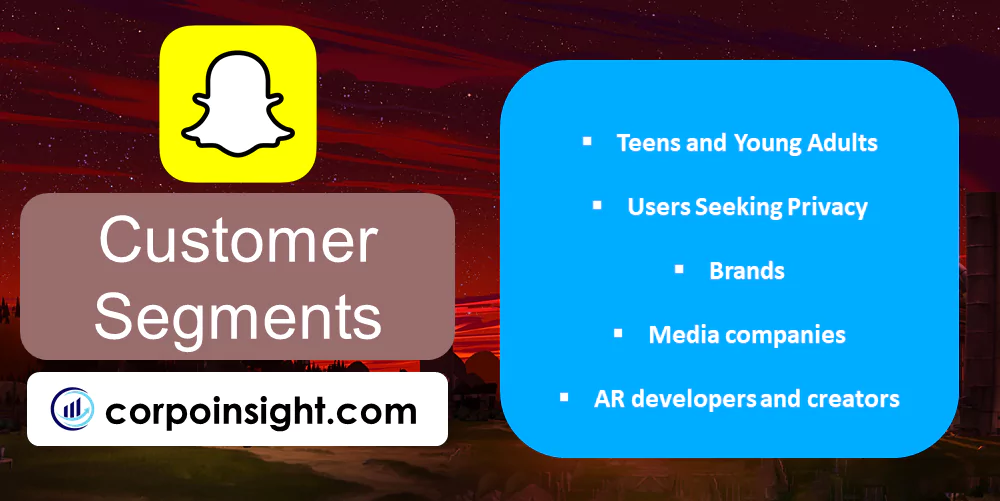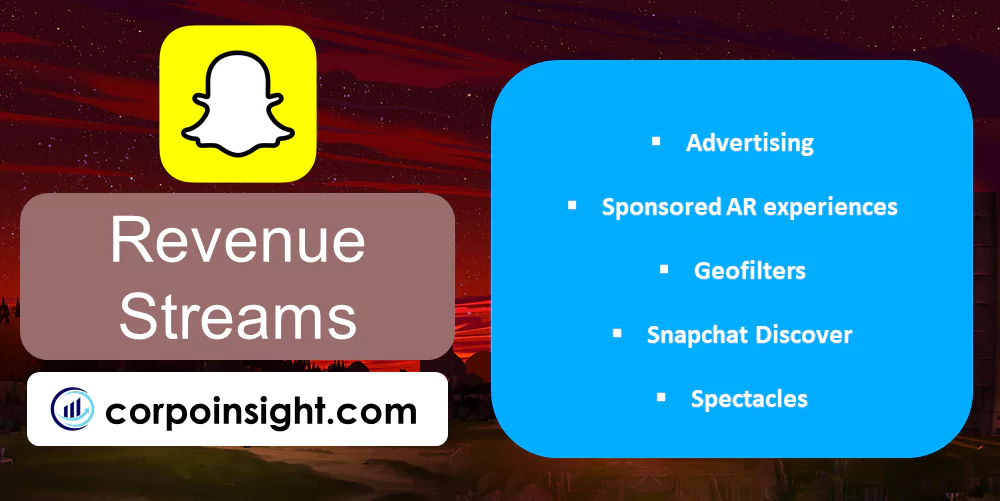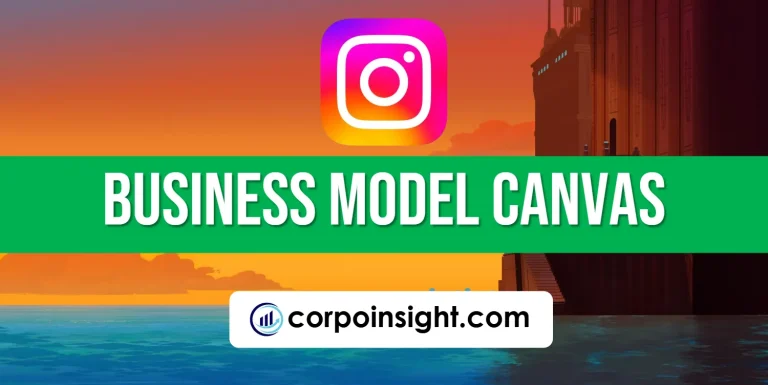Snapchat Business Model Canvas 2024
A revolutionary app enabling ephemeral sharing of photos and videos, Snapchat has become a cultural phenomenon and daily habit for millions since originally launching as Picaboo in 2011. Here, in this Snapchat business model canvas, we will learn its customer segments, value proposition, revenue streams, channels, customer relationships, key activities, key resources, key partners, and cost structure.
Interesting fact!
Snapchat turned down a $3 billion acquisition offer from Facebook in 2013.
Snapchat Competitors
Instagram | TikTok | Facebook | YouTube | Twitter | Pinterest | Telegram | WhatsApp | LINE | WeChat
Customer Segments – Snapchat Business Model Canvas

Teens and Young Adults: Over 90% of Snapchat’s users are between the ages of 13 and 24, with this demographic making up the majority of their 363 million daily active users, making it a popular communication method and social media platform among youth.
Users Seeking Privacy: With its disappearing messages and “Stories” that vanish in 24 hours, Snapchat provides a more temporary and intimate way of sharing moments than permanent platforms like Facebook.
Brands: Major companies across industries like entertainment, fashion, and CPG actively leverage Snapchat for influencer marketing campaigns and sponsored filters/lenses to engage with their younger target markets.
Media companies: Major media publishers like CNN, ESPN, NBC, and Buzzfeed have established content channels on Snapchat Discover to tap into younger audiences that consume content mainly on mobile devices.
AR developers and creators: Snapchat’s suite of AR tools, world lenses, and popular filters have enabled creators, developers, and businesses to build customized augmented reality experiences on the platform.
Value Proposition – Snapchat Business Model Canvas

Ephemerality and privacy: Snapchat’s ephemeral messaging style gives users control over what they share and with whom, offering a more private social media experience.
Unique communication style: Snapchat pioneered the “Stories” format of sharing moments over 24 hours, enabling a different form of visual communication compared to permanent feeds on other platforms.
AR creativity: With its augmented reality lenses and filters, which are used by over 250 million daily active users, Snapchat offers interactive visual effects that enhance communication.
Authenticity: The temporary nature of content leads to more authentic in-the-moment sharing for users. Brands also leverage this authenticity for marketing campaigns.
Younger audience: Snapchat is able to attract a sought-after and often hard-to-reach younger demographic within the high-growth mobile social media market, which is valuable for advertisers and marketers.
Revenue Streams – Snapchat Business Model Canvas

Advertising: Snap sells ad spots within Stories, AR lenses and filters, Discover channels, and elsewhere, making the bulk of its revenue from brands seeking to reach younger audiences.
Sponsored AR experiences: Branded sponsored lenses and filters are purchased by advertisers and enable interactive AR experiences and collaboration with top Snapchatters and influencers.
Geofilters: Sponsored filters targeted by location generate revenue from both regular users sending geofilters and brands sponsoring custom geofilters for events or promotions.
Snapchat Discover: Media partners pay Snapchat to host their curated content channels within the Discover section, which features original shows and content.
Spectacles: Snapchat’s camera-enabled Spectacles glasses have offered direct e-commerce revenue through sales, although overall hardware sales have been limited.
Channels – Snapchat Business Model Canvas

Mobile app: As a mobile-first platform, Snapchat is accessed primarily via its iOS and Android apps, which had over 363 million daily active users as of 2022, making it one of the most popular mobile apps globally.
App marketplaces: Snapchat has gained many new users through featuring on the Apple App Store and Google Play Store, where the app has consistently been a top downloaded app since its launch.
Influencer marketing: Collaborations with celebrities, influencers, and top Snapchatters with large followings provide exposure to and endorsement of Snapchat from relevant public figures.
Cross-platform sharing: The ability to easily share Snapchat content across other platforms like Instagram and Twitter also assists with user acquisition and onboarding.
Traditional advertising: Snapchat carries out extensive online, TV, out-of-home, and print advertising, particularly targeted at younger demographics to boost brand awareness and app installs.
Customer Relationships – Snapchat Business Model Canvas

In-app communication: Snapchat fosters direct communication between friends and connections solely within the app through features like messaging, video/voice calls, and stories.
Feedback gathering: Snapchat frequently polls users within the app and analyzes usage data to gather direct feedback about existing and potential new features.
Campus Marketing: On-the-ground marketing efforts at high schools and colleges allow Snapchat to engage student users directly to build affinity with its key younger demographic.
Influencer collaborations: Partnerships with influencers, celebrities, and brands enable Snapchat to build relationships with users through aspirational, unique content.
Customer support: While primarily digital, Snapchat also provides email, in-app bot, and phone customer support to field questions, complaints, and feedback from users.
Key Activities – Snapchat Business Model Canvas

Product research & development: Snap invests heavily in ongoing R&D of new and improved social media, messaging, camera, and AR features to evolve the app experience constantly.
AR technology: Snapchat’s industry-leading augmented reality capabilities require focused investment into advanced AR tools, lenses, and effects.
Content partnerships: Snapchat dedicates resources to sourcing, funding, and promoting content from media publishers, brands, and influencers for Discover and Stories.
Ad platform development: Building out and advancing Snapchat’s advertising platform for performance and automation of ad purchasing, tracking, and optimization is a key activity.
Geographic expansion: Snapchat continuously localizes its apps, marketing, language support, and content to extend its reach in international markets, especially faster-growing developing regions.
Key Resources – Snapchat Business Model Canvas

Engineering talent: Snapchat employs hundreds of engineers and developers to build and enhance its apps, AR capabilities, ad platform, and other technology.
Computing infrastructure: Operating Snapchat’s apps, features, and services requires secure cloud infrastructure and vast server capacity across Google Cloud, AWS, and other providers.
User data: Snapchat has access to rich behavioral data on over 363 million daily active users, enabling data-driven product development and ad targeting.
Brand partnerships: Snapchat’s partnerships with brands, publishers, influencers, and creators provide exclusive content and sponsorship opportunities.
Intellectual property: Snapchat has an extensive patent portfolio around mobile messaging, AR technology, social media advertising, and more to protect its innovations.
Key Partners – Snapchat Business Model Canvas

App stores: Distribution partnerships with Apple App Store and Google Play Store are critical for user acquisition and delivering updates.
Advertisers: Snapchat enables leading brands across industries to reach its young user base through innovative ad products and measurement.
Content providers: Media companies like ESPN, NBC, BuzzFeed, and more create content for Snapchat Discover to engage users while monetizing through revenue sharing.
Influencers: Collaborations with celebrities, creators, and influencers boost user growth and engagement while providing influencers monetization opportunities.
AR developers: Snap provides AR lens development kits and tools to external developers to expand its library of augmented reality experiences.
Cost Structure – Snapchat Business Model Canvas

Research and development: Snapchat invests heavily in ongoing R&D for its apps, AR technology, ad products, and more. R&D spending topped $1 billion in 2021.
Hosting and bandwidth: Snapchat’s server and cloud hosting costs are substantial to support millions of users across services like video/voice calls.
Marketing and advertising: Snapchat spends significantly on marketing, advertising, and brand partnership campaigns, especially those targeting younger demographics.
Content acquisition: Snapchat offers revenue sharing and other compensation to media partners, influencers, and creators for exclusive content.
Employee compensation: Snapchat has over 6,000 employees in engineering, content, sales, marketing, and other roles, contributing to salary and benefit costs.
Summary of Snapchat Business Model Canvas

Conclusion on Snapchat Business Model Canvas
Snapchat has innovated an engaging, entertainment-centric platform targeted at younger users and monetized it through native advertising while offering brands access to this coveted audience. Its investment in differentiated capabilities like AR demonstrates Snapchat’s focus on evolving its product and user experience.

This is Ahsanul Haque, someone very passionate about digital marketing, SEO, and Data Analytics and founder of the Analytics Empire and currently pursuing my major in marketing at Bangladesh University of Professionals.






